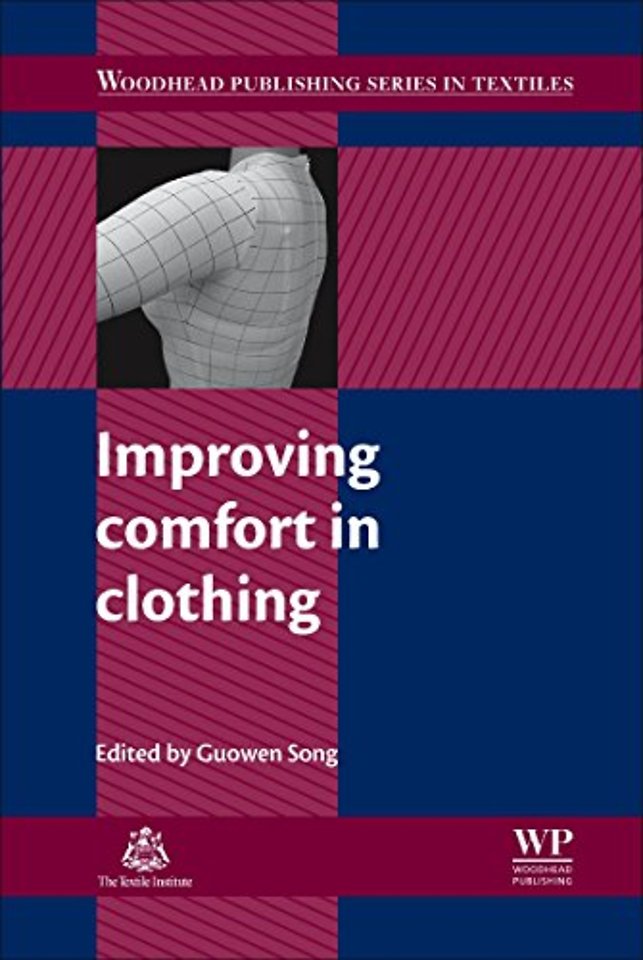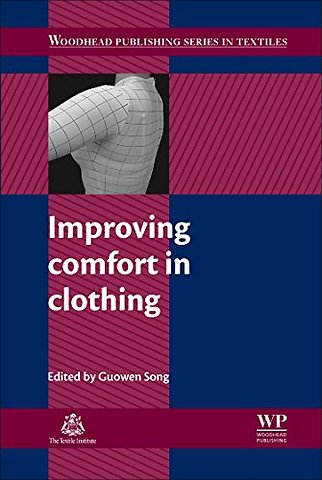<p>Contributor contact details</p> <p>Woodhead Publishing Series in Textiles</p> <p>Preface</p> <p>Part I: Fundamentals of comfort and assessment</p> <p>Chapter 1: Factors affecting comfort: human physiology and the role of clothing</p> <p>Abstract:</p> <p>1.1 Definition of comfort</p> <p>1.2 Human physiological aspect of comfort</p> <p>1.3 Energy metabolism and physical work</p> <p>1.4 Human heat balance</p> <p>1.5 Clothing as near environment</p> <p>1.6 Various aspects of clothing comfort</p> <p>1.7 Comfort variables</p> <p>1.8 Effective temperature and the comfort chart</p> <p>1.9 Response to extreme temperature</p> <p>1.10 Development of heat stress and its control</p> <p>1.11 Protective clothing</p> <p>1.12 Future trends and further information and advice</p> <p>Chapter 2: Properties of fibers and fabrics that contribute to human comfort</p> <p>Abstract:</p> <p>2.1 Introduction</p> <p>2.2 Comfort properties of fibers</p> <p>2.3 Physical modification of fibers</p> <p>2.4 Comfort properties of yarns</p> <p>2.5 Comfort properties of fabric structures</p> <p>2.6 Conclusions</p> <p>Chapter 3: Wool and garment comfort</p> <p>Abstract:</p> <p>3.1 Introduction</p> <p>3.2 Wool quality</p> <p>3.3 Benchmarking: wool quality in retail garments</p> <p>3.4 Comfort in wool garments: a new assessment protocol</p> <p>3.5 Wool garment comfort assessment</p> <p>3.6 Comfort response of individuals</p> <p>3.7 Wool quality and garment comfort</p> <p>3.8 Conclusions</p> <p>3.9 Sources of further information and advice</p> <p>3.10 Acknowledgments</p> <p>Chapter 4: How consumers perceive comfort in apparel</p> <p>Abstract:</p> <p>4.1 Introduction</p> <p>4.2 How humans sense comfort</p> <p>4.3 The Nervous System</p> <p>4.4 Human brain</p> <p>4.5 Skin and its functions</p> <p>4.6 Structure of the skin</p> <p>4.7 Senses and sensory receptors</p> <p>4.8 Skin and senses</p> <p>4.9 Sensations and fabrics</p> <p>4.10 Psychological factors and overall comfort perception</p> <p>4.11 Conclusions</p> <p>Chapter 5: Laboratory measurement of thermo-physiological comfort</p> <p>Abstract:</p> <p>5.1 Introduction</p> <p>5.2 Thermo-physiological comfort</p> <p>5.3 Thermal resistance</p> <p>5.4 Water vapour transport</p> <p>5.5 Air permeability</p> <p>5.6 Wicking, buffering and absorbency</p> <p>5.7 New developments and future trends</p> <p>Chapter 6: Testing, analyzing and predicting the comfort properties of textiles</p> <p>Abstract:</p> <p>6.1 Introduction</p> <p>6.2 Characterization of comfort</p> <p>6.3 Testing, analyzing and predicting neurophysiological comfort</p> <p>6.4 Testing, analyzing and predicting thermophysiological comfort</p> <p>6.5 Design-oriented comfort model</p> <p>6.6 Future trends</p> <p>Part II: Improving comfort in apparel</p> <p>Chapter 7: Improving thermal comfort in apparel</p> <p>Abstract:</p> <p>7.1 Introduction</p> <p>7.2 Different approaches for improving the thermal comfort of clothing</p> <p>7.3 Conclusions</p> <p>Chapter 8: Improving moisture management in apparel</p> <p>Abstract:</p> <p>8.1 Introduction</p> <p>8.2 Transport of perspiration</p> <p>8.3 Fundamentals of moisture transfer between the human body and the environment</p> <p>8.4 Factors influencing moisture transport</p> <p>8.5 Improving moisture transport</p> <p>8.6 Clothing requirements for different environmental conditions</p> <p>8.7 Developments in moisture management</p> <p>8.8 Future trends</p> <p>Chapter 9: Improving tactile comfort in fabrics and clothing</p> <p>Abstract:</p> <p>9.1 Introduction</p> <p>9.2 Comfort and neurophysiology</p> <p>9.3 Human tactile sensation</p> <p>9.4 Fabric mechanical properties and tactile-pressure sensations</p> <p>9.5 Warmth or coolness to the touch of fabrics</p> <p>9.6 Improving the textile surface properties for tactile sensation</p> <p>9.7 Predictability of sensory comfort</p> <p>9.8 Improving electrostatic propensity</p> <p>9.9 Future trends</p> <p>9.10 Conclusions</p> <p>Chapter 10: Garment pattern design and comfort</p> <p>Abstract:</p> <p>10.1 Introduction: fundamental principles of fit in apparel</p> <p>10.2 Clothing comfort and fit</p> <p>10.3 Manual and mechanical stretch testing</p> <p>Results</p> <p>10.4 Stretch pattern development</p> <p>10.5 Future trends</p> <p>10.6 Conclusions</p> <p>10.7 Sources of further information and advice</p> <p>Chapter 11: Improving body movement comfort in apparel</p> <p>Abstract:</p> <p>11.1 Introduction: fundamental principles of movement in apparel</p> <p>11.2 Fashion and functional apparel: aesthetics, protection, performance and movement</p> <p>11.3 Materials and design strategies to provide appropriate movement performance</p> <p>11.4 Movement and garment stretch/pressure/compression</p> <p>11.5 Research and testing of prototype designs for comfort and movement</p> <p>11.6 Future trends</p> <p>11.7 Sources of further information and advice</p> <p>Part III: Improving comfort in particular types of clothing</p> <p>Chapter 12: Evaluating the heat stress and comfort of firefighter and emergency responder protective clothing</p> <p>Abstract:</p> <p>12.1 Introduction</p> <p>12.2 Background</p> <p>12.3 Laboratory tests for clothing heat stress</p> <p>12.4 Laboratory tests for clothing comfort</p> <p>12.5 Research needs</p> <p>Chapter 13: Improving comfort in military protective clothing</p> <p>Abstract:</p> <p>13.1 Introduction</p> <p>13.2 Historical perspective</p> <p>13.3 Threat level and concept of operations</p> <p>13.4 Understanding system level whole-body protection: baseline performance</p> <p>13.5 Civilian style protective systems</p> <p>13.6 Adsorptive undergarments</p> <p>13.7 Cold War individual protective equipment</p> <p>13.8 Post-Gulf War individual protective equipment</p> <p>13.9 Asymmetric operations (individual protective equipment)</p> <p>13.10 Conclusions</p> <p>13.11 Future trends</p> <p>13.12 Acknowledgements</p> <p>Chapter 14: Balancing comfort and function in textiles worn by medical personnel</p> <p>Abstract:</p> <p>14.1 Introduction</p> <p>14.2 Surgical gowns</p> <p>14.3 Surgical gloves</p> <p>14.4 Surgical masks</p> <p>14.5 Future trends</p> <p>Chapter 15: Improving comfort in sports and leisure wear</p> <p>Abstract:</p> <p>15.1 Introduction</p> <p>15.2 Market share of sports and leisure wear and affected group of users</p> <p>15.3 Definition of sports and leisure wear</p> <p>15.4 Influence of sportswear on everyday and leisure wear fashion</p> <p>15.5 Physiological demands on sports, everyday and leisure wear</p> <p>15.6 Testing sports, everyday and leisure wear comfort</p> <p>15.7 Textile constructions for sports, everyday and leisure wear</p> <p>15.8 Application examples</p> <p>15.9 Recent and future trends in sports, everyday and leisure wear</p> <p>15.10 Future trends in testing comfort of sports, everyday and leisure wear</p> <p>15.11 Conclusions</p> <p>15.12 Sources of further information and advice</p> <p>Chapter 16: Cold weather clothing and comfort</p> <p>Abstract:</p> <p>16.1 Introduction</p> <p>16.2 Thermal comfort and heat balance</p> <p>16.3 Requirements for comfort in the cold</p> <p>16.4 Principles for cold weather clothing</p> <p>16.5 Future trends</p> <p>Chapter 17: Achieving comfort in intimate apparel</p> <p>Abstract:</p> <p>17.1 Introduction</p> <p>17.2 Sensorial comfort for intimate apparel</p> <p>17.3 Thermal comfort for intimate apparel</p> <p>17.4 Motion comfort for intimate apparel</p> <p>17.5 Aesthetic comfort for intimate apparel</p> <p>17.6 Hygienic comfort for intimate apparel</p> <p>17.7 Acknowledgement</p> <p>17.8 Sources of further information and advice</p> <p>Index</p>

